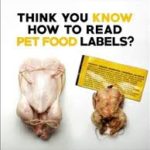Labels–the guaranteed analysis
by Dr. Becky Marks
Firstly, an diet that says “for all stages of life” you already have problems. All diet have modications for the various stages of life. A puppy requires lots more in fat , calories and proteint for growth . The old lab that really is overweight and winding down needs less fat, calories and protein. It is that simple.

Many Clients now looks for grain free diets. The idea implies that grains cause allergies or gluten issues. This is not the case. Keep in mind that cats and dogs in the will eat grains whenever they catch a rodent or rabbit they eat the GI contents for the extra (green) nutrition.
In the process of reading the pet food bag there is a lot of information that you might skim over. In the case of the recalls you quickly read through the ingredient list and relied on the accuracy of the label. Labels that have the American Feed Control Official (AAFCO) approval means the law has defined what can be used for manufacture. These are the minimum requirements. Some companies go beyond the basics. Better companies use human grade ingredients. Others use human non-edible grades. There are also quality standards regarding packaging, physical integrity of the food, adequacy of sterilization, freedom from toxins and microbes. Canada and Europe have different guidelines.
Remember that more nutrients are NOT always better in pet nutrition — many nutrients are actually toxic in excessive amounts! And every dog and cat has unique nutritional needs based on age, health and activity level.
Ingredients: Ingredients are required to be listed in their proper order of predominance by weight. The weights of ingredients are determined as they are added in the formulation, with their inherent water content. Water content greatly affects the weight of the listed ingredients. If the food is listed on As-is analysis then water is present and the calculations would need to be recalculated on the Dry Matter basis. For example, one pet food may list “chicken” as its first ingredient, and “corn” as its second. The manufacturer doesn’t hesitate to point out that its competitor lists “corn” first (chicken meal is second). However, chicken is very high in moisture (approximately 75% water). On the other hand, water and fat are removed from chicken meal, so it is only 10% moisture. If we compared both products on a dry matter basis, one could see that the second product had more chicken meal than the first product had chicken.
Some categories such as meat, meat by-products, and poultry by-products are confusing.Meat is the clean flesh of slaughtered animals (chicken, cattle, lamb, turkey, etc.). The flesh can include striated skeletal muscle, tongue, diaphragm, heart, esophagus, overlying fat and the skin, sinew, nerves and blood vessels normally found with that flesh.Meat By-products: Meat by-products are clean parts of slaughtered animals, not including meat. These include lungs, spleen, kidneys, brain, liver, blood, bone, and stomach and intestines freed of their contents. It does not include hair, horns, teeth, or hooves.Poultry By-products: Poultry by-products are clean parts of slaughtered poultry such as heads, feet, and internal organs (like heart, lungs, liver, kidneys, abdomen, and intestines). It does not contain feathers.
Guaranteed analysis:
As you scan the guaranteed analysis you will see the breakdown of categories: Protein, Carbohydrates, Fats, Water, Vitamins and Minerals. Protein is the main element of body tissues like muscles, blood, skin, organs, hair and nails. Carbohydrates provide energy for the body’s tissues. Fats absorb, store and transport vitamins, moisturize skin and coat, make healthy pet food taste great and supply energy. Water is the most critical nutrient for survival. Vitamins assist in maintaining an animal’s metabolism. Minerals are necessary to develop healthy skin and hair, proper skeletal support and development. Minerals are usually abundant in pet food ingredients.
Minimum and maximum levels are in the guaranteed analysis. This may have some advantages when you are concerned about the maximum fat in a diet. However, in a pet with kidney disease the level of protein will be the main item of concern. Low protein is critical for kidney patients. When the level states “minimum’ protein 21% you have know idea what the maximum value may be. Now you are learning how to read “between the label lines’. At minimum, a pet food label must state guarantees for minimum percentages of crude protein and crude fat, and maximum percentages of crude fiber and moisture. The “crude” term refers to the specific method of testing the product, not to the quality of the nutrient itself.
Some manufacturers include guarantees for other nutrients as well. Maximum ash is often guaranteed, especially on cat foods. Cat food commonly also bear guarantees for taurine and magnesium as well. For dog foods, minimum levels of calcium, phosphorus, sodium, and linoleic acid are found on some products. If the guarantees don’t include information on a particular nutrient that you are interested in, ask the company, or don’t buy the product.
Comparing the guaranteed analyses of dry and canned products, one will note that the levels of crude protein and most other nutrients are much lower for the canned product. This can be explained by looking at the relative moisture contents. Canned foods typically contain 75-78% moisture, whereas dry foods contain only 10-12% water. To make meaningful comparisons of nutrient levels between a canned and dry product, they should be expressed on a similar moisture basis. To roughly approximate this, the guarantees for the canned product should be multiplied by four.
When buying a canned food, look at the moisture guarantee. The maximum moisture content for a pet food is 78%, except for products labeled as a “stew,” “in sauce,” “in gravy,” or similar terms. The extra water gives the product the qualities needed to have the appropriate texture and fluidity, but you are paying for it.
Nutritional Adequacy Statement will also state for which life stage(s) the product is suitable, such as “for maintenance, or “for growth.” A product intended “for all life stages” meets the more stringent nutritional needs for growth and reproduction A maintenance ration will meet the needs of an adult, non-reproducing dog or cat of normal activity, but may not be sufficient for a growing, reproducing, or hard-working animal. Puppy/kitten, adult maintenance, low activity and senior pets can easily have their needs met with respective diets for each stage.
Feeding Guidelines:
Feeding guidelines instruct the consumer on how much product should be offered the animal. At minimum, they should include verbage such as “feed ___ cups per ____ pounds of body weight daily.”The feeding directions should be taken as rough guidelines, a place to start. Breed, temperament, environment, and many other factors can influence food intake. The best suggestion is to offer the prescribed amount at first, but don’t be afraid to increase or cut back as your eye guides you.
Trusting the information on the label will be difficult for you with regard to the recent recalls. The Pet Food Institute has just announced the formation of a National Pet Food Commission. The purpose of the Commission is to investigate the cause of the recall and to recommend steps the industry and government should take to further build on safety and quality standards already in place. The Commission is an industry/government partnership composed of government officials, veterinarians, toxicologists and food scientists who are committed to maintaining and enhancing the high standards we have set in this country that protect our pets.
